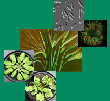| Hansen, J; Beck, E: Seasonal-changes in the utilization and turnover of assimilation products in 8-year-old scots pine (Pinus-sylvestris L.) trees, Trees, 8, 172-182 (1994), doi:10.1007/BF00196844 | |
| Abstract: The present study aimed at a physiological understanding of the seasonal changes of the carbohydrate patterns and levels in the various tissues of 8-year-old Scots pine (Pinus sylvestris L.) trees growing under ambient climatic conditions in the botanical garden at Bayreuth. The photosynthates of selected twig sections were labelled by 14CO2 fixation and after chase periods of 1 h up to 8 months, the distribution of radiocarbon in the whole trees was determined and the labelling of identified carbohydrates was compared with the levels of these compounds in the individual tissues. Bud break and sprouting in spring is exclusively supplied by the recent photosynthates of the previous year's needles. During summer assimilates of the old needles were utilized for secondary growth of the axial system while growth of the recent-year's shoots was supported by their own photosynthesis. In autumn, soluble carbohydrates were produced instead of starch, a major part of which in addition to recent photosynthates was utilized for root growth during the cold season. Another part of the autumnal storage material was incorporated into the cell walls of the latest xylem and phloem elements still in winter. A pronounced starch-oligosaccharide interconversion upon frost hardening, and its reversal in spring as has been described for deciduous trees, could not be observed. This was due to maintenance of photosynthetic capability even in the cold season and the replacement of consumed storage material especially in late winter and early spring by new photosynthates. |

last modified 2020-07-06

